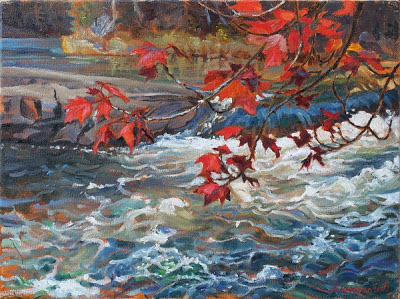Alien Infiltration (oil on canvas 5 x 7 in.) SOLD!
20 July finds us in Heber Down Conservation Area, Whitby, Ontario, and I am sitting in front of the largest Cedar tree I've seen east of British Columbia. Fred, who had wandered off exploring as we set up camp, returned saying "get out your black paint". At his direction, I stepped from the mowed lawn of Group Campsite #2 into the entrance of a little trail. As soon as I saw the old Cedar I was awestruck, and then appalled as the scene turned from romantic to gothic.
The venerable giant is surrounded and caged by five Buckthorns - bushes that have grown into trees, stretching up to steal the light from its canopy, leaning, vine-like on its outstretched limbs. Reaching the sunlight, the oval coins of their leaves displace the dark feathery Cedar foliage - each year a little more.
I started by sketching with a rubber-tipped tool, faint lines following trunks and limbs into the dark purplish grey underpainting, noticing how a Buckthorn trunk leans against a lower Cedar limb and then behind the limb above, lacing itself up into the Cedar. Spidery grey dead twigs complete the impression of Buckthorn basketry.
Adam comes to photograph me at work and we talk about cutting the Buckthorns and releasing the old Cedar, but I think that kind of commotion would disturb the Honeybees that have made their home in the back of the tree, a little above head height.
Fred has measured the diameters of the Buckthorns at breast height. The largest trunk is 13 cm. and the average diameter is 6.8 cm.
The venerable giant is surrounded and caged by five Buckthorns - bushes that have grown into trees, stretching up to steal the light from its canopy, leaning, vine-like on its outstretched limbs. Reaching the sunlight, the oval coins of their leaves displace the dark feathery Cedar foliage - each year a little more.
I started by sketching with a rubber-tipped tool, faint lines following trunks and limbs into the dark purplish grey underpainting, noticing how a Buckthorn trunk leans against a lower Cedar limb and then behind the limb above, lacing itself up into the Cedar. Spidery grey dead twigs complete the impression of Buckthorn basketry.
Adam comes to photograph me at work and we talk about cutting the Buckthorns and releasing the old Cedar, but I think that kind of commotion would disturb the Honeybees that have made their home in the back of the tree, a little above head height.
Fred has measured the diameters of the Buckthorns at breast height. The largest trunk is 13 cm. and the average diameter is 6.8 cm.




The circumference of the Cedar at breast height is 201cm, so the DBH=64cm. The diameters of the 24 stems of the 5 Rhamnus cathartica Buckthorn at breast height average 68.1 mm (range 43.5 - 129mm; st.dev.=22.28mm). Aleta doesn't mention in her text that the alien surround is completed by a 70cm deep ground cover of Vincetoxicum Dog-strangling Vine, and that there's lots of little Vincetoxicum seedlings around the Thuja.
ReplyDeletehere's what I wrote to the NatureList about aliens seen on this trip: Everyone, We're well back from our excursion to deepest Whitby now, and are even well over the shock at the nativist appearance of our streams and towns, where our newly accustomed eyes have been screaming out "Where's the invasive aliens?" for the past few days.
ReplyDeleteWe found that the streams draining into Lake Ontario are perplexingly barren, even despite the number of Carp around, but the banks are thronged by alien plants - leading to songs such as:
Dog-strangling Vine,
Dog-strangling Vine,
Toronto thinks it is just fine
To see that everything's entwined
by thickets of Dog-strangling Vine.
We were stunned by the extent to which the Pink Jewelweed, Impatiens glandulifera, Jerusalem Artichoke (Helianthus tuberosus), Bishops- or Gout-weed (Aegopodium podagraria), the amazing Dog-strangling Vine, Vincetoxicum, and Colts-foot (Tussalago farfara) have taken over the valleys of streams that drain into Lake Ontario since 1994 when we did the surveys for "A Place to Walk." The fields back from Wilmot Creek are surrealistic with DS-V and Pink Jewelweed in a way that Salvador Dali, with his spartan style, couldn't possibly capture. Upper Lynde Creek is lined with Aegopodium to an extent I've never seen before anywhere. This is a species that's not supposed to spread by seeds, but I bet it's doing that along Lynde Creek - southern Ontario, kiss yourself goodbye.
When there's anything in the water it's the European Potamogeton crispus. Streams that "look like" they'd be packed with mussels and snails around here are just barren flats of sand and gravel, and we could only suppose that spring spates and thunderstorms (amplified by storm sewer systems) keep them too churned up for anything to grow to maturity. Looking for Unionids in the Lynde Creek Marsh, we found nothing but Carp -- the one factor I'd left out of my "refuge-from-Zebras" model of Lake Erie estuaries, though how one could forget about Carp after the way they banged into our canoe on the trip we took along the waterfront in 1994 is something I can't explain.
Also Fire Ants are painfully plentiful along the lakeshore, and a snail that's very much like Succinea putris is ubiquitous - just amazingly gratuitously everywhere - on plants, under boards, floating on drift, and dying of sunstroke out on boardwalks; I've collected about half a gallon of them to send to real malacologists for identification.
It was a relief to get out of the GTA and see a Succineid that looked like Novisuccinea ovalis on the banks of the Salmon River at Shannonville (where we also found the endangered mussel Villosa iris, (showing that this species extends down to the mouth of the river), no Zebra Mussels, and one plant of Mirabilis nyctaginea, or Four-o'Clock, which I've never recognized before